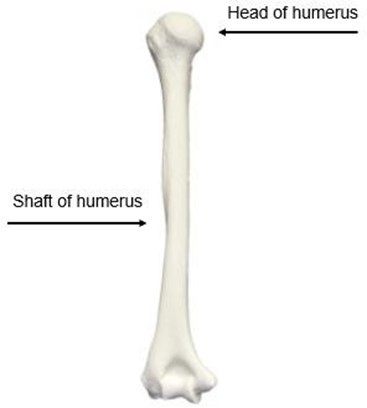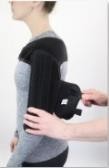Neurodiversity information for parents and young people
About a humeral shaft fracture
The humerus bone is in the upper part of the arm.
It can be painful when broken and may take 9 to 12 weeks to heal.

What to expect if you fracture your humerus
If you fracture your humerus you can expect the following.
Pain and discomfort
This injury can be painful and you will need regular painkillers. We will prescribe these for you before you are discharged from hospital.
Swelling
Swelling will affect your arm and hand. It may take a few weeks to develop.
It will go down over time if you do some regular exercises.
Bruising
This often occurs to the arm, hand and chest. It takes some time to get better.
How to manage a humeral shaft fracture
- We can fit a brace to hold the bone in place. The brace will feel supportive and hold the upper arm in place. It covers your shoulder to your elbow and wraps around your arm to give support.
- We also give you a sling to support your hand and to allow your arm to relax.
- When you wear the sling, your hand needs to be higher, or at about the same level, as your elbow.
- We will also give you a stocking to wear between your skin and the brace.
Length of time you will need to wear the brace
The Plaster Room will let you know how long you will need to wear the brace and when you can remove it.

Regular exercises that we recommend
Use the drop-down menu for exercises that we recommend.
- Do the exercises at least twice a day.
- Repeat each exercise slowly 5 times. Repeat the full set if you can.
- Always stop exercising if you experience pain.
|
Start with your fingers straight. Make a fist, being sure that you bend each finger as much as possible.
|
|
Straighten your fingers as much as possible. Start with your fingers straight and together. Spread your fingers wide apart and then bring them back together.
|
|
Start with your fingers straight, then move your wrist up and down.
|
|
Remove your arm from the sling and slowly allow your arm to straighten. Bring your arm back upwards. Use your other arm for support under your elbow.
|
Exercise images: Health Information Translations
General advice on wearing your humeral brace
![]()
- Remove your brace once a day so you can wash and make sure your skin looks healthy.Check your skin for any irritation, red marks, broken skin or blisters.
- Keep your hand and fingers moving throughout the day.
- Remove your arm from the sling regularly to check your skin and prevent stiffness in your elbow.
- Regularly exercise the joints that are not covered by the cast, to avoid stiffness.
- Relax your shoulder to allow your arm to hang. This will allow the muscles in your arm to relax and keep the bone straight.
- Take regular painkillers if you need them.
- If you are a smoker, we advise you to stop smoking as it can slow, and sometimes stop, the healing process.
![]()
- Do not put anything under the brace (such as tissue or creams) as this can cause skin problems.
- When sitting, do not place anything under your arm. Your arm needs to hang free to allow the bone to stay straight.
- Do not get the brace wet. If the brace gets wet, it can damage your skin and increase the risk of infection
- Do not wear jewellery on your hand or wrist. This allows room for temporary swelling.
How to wash the brace
- Remove the bars to wash the brace.
- Hand wash the brace in a light detergent and leave it to airdry.
Clasby humeral brace fitting and adjustment instructions
We measure and trim your brace when we fit it.
When you reapply your brace, follow the advice below or use the QR code to see a video. You may find it easier to reapply if someone can help you.

|
Put the brace up to your arm. The middle bar should run down the side of your arm to your elbow. Your arm will need support so hold your arm up with your other arm.
|
|
Lean to the side, allowing a gap between your arm and the side of your body, while still supporting your arm. Wrap the brace around your arm and attach it with the two Velcro straps. The brace needs to apply some compression but do not overtighten it.
|
|
Apply the compression straps using the Velcro tabs and tighten them to hold your arm in place. Pull the straps through the D rings from both sides to allow even pressure and fix the Velcro around the arm.
|
|
Guide the shoulder strap around your back and under your arm. Clip it under the front of your chest. Make sure there is enough tension to prevent your shoulder from rising.
|
|
Finish by putting the sling back on. Make sure that your arm is supported and your hand is higher or at the same level as your elbow.
|
|
|
When to contact the Plaster Room or A&E
Contact the Plaster Room or the A&E Department, if you experience any of the following.
- Pins and needles or numbness or loss of sensation in your arm or hand. This can mean that the brace is too tight and needs adjustment.
- A burning feeling or blister like pain underneath the brace. This can mean the brace is rubbing or causing pressure on the skin.
- Pain that increases or becomes more frequent and is not made better with regular painkillers.
- Difficulty moving your fingers, hand, and wrist. You must be able to move all body parts that are not limited by the brace.
- The brace becomes loose and does not provide support to your arm.
- The brace gets wet or soiled, damaged, or broken
- A discharge or smell coming from the brace
- Your skin breaks down or becomes sore
- You need a replacement stocking
- You have any concerns regarding the brace.
Contact information
Kingston Hospital Plaster Room, Monday to Friday 8.30am to 5pm
or
Kingston Hospital Orthopaedics Outpatient Department, Monday to Friday 9am to 5pm








